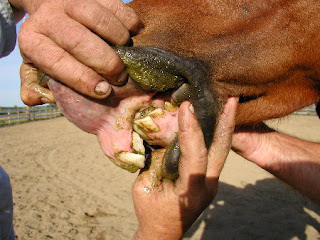As a review from yesterday I challenge you to make flashcards for the following terms. See how many you can do without looking them up.
foal, stallion, stud, mare, dam, sire, pony, hand, gelding
Read through this site on horse colors. I will quiz you on it on Tuesday. There are more colors than we discussed since Sammy was falling asleep.
http://www.equusite.com/articles/basics/basicsColors.shtml
Since I am sick and quite possibly dying (yes...I'm being melodramatic), I thought I'd post what were going to talk about today on here. I'm going to try to add stuff regularly thoughout the next couple weeks, so that you can get more than just what we are learning in our meetings. Please try to follow me on here, because this information will be invaluable to the contest.
So today's topic is going to be Horse Nutrition!!!! YAY FOOD! Which will lead into horse feeds and feeding and all that good stuff so your horse doesn't die, and you don't get arrested for animal abuse.
To really understand horse nutrition you should first understand the digestive system.
Please read through this quick bulletin from the Ohio Extension:
http://ohioline.osu.edu/b762/b762_5.html
One point I really want you to take away is the horse has a unique cecum for a non-ruminant or monogastric. Cows eat grass effectively, because they have the super awesome stomach of a ruminant. Well, horses are monogastric, but they also eat grass. Why can't we eat grass too? Well we can, but it tastes disgusting...seriously try it. Horses have an enlarged cecum. We do not. Sometimes they are referred to as pseudoruminants for this exact reason. The cecum (as you read) acts similarly to a ruminant's multi compartment stomach. That's pretty neat!
Quiz time:
What does it mean when we say horses are herbivores?
How many teeth do horses have (male vs. female)?
What two things help break down food in the stomach?
If a feed change occurs how long does it take for the microbes in the cecum to change to be able to properly digest the new feed?
Answers:
Eats forages instead of meat.
Females= 36 teeth
Males=40 teeth
Pepsin & Hydrochloric Acid
appx 3 weeks
The main feed ingrediates that horses need are going to be carbohydrates, fats, protein, minerals, vitamins and water. Carbohydrates, fats, and proteins are what is necessary for a horse to generate energy. Carbs are the main energy source. No Atkins Diet for horses. Horses will gain these from grains and roughages. This includes pasture grasses.
Nutrients are neceesary to maintain body weight and support digstive/metabolic functions. Additional nutrients will be required for growth, work, reproduction and lactation. That is why feed will change based on what the horse is used for. A pregnant mare will receive different nutrients than a horse that does cross country jumping.
Most horses receive their feed in two different parts. They get roughage (hay or pasture) and concentrates (grains and supplements).
Answer the following question to the best of your ability based off of what you already know. We will discuss on Tuesday. What can nutritional deficiencies lead to?
Side note: After 3 years horses become lactose intolerant. If you give a mature horse milk it will get diarrhea.
Fat is often used to increase performance and maintain body condition. It should be included in a performance horse diet. We do not know the ideal amount yet, so trainers often have to play around with the amount to add on a daily basis.
Look up and define the following terms thare used to measure energy: Digestible energy, metabolizable energy, net energy and total digestible nutrients.
Proteins are amino acids. Research has shown that proteins high in lysine (an amino acid) achieved the greatest growth. Mature horses do not need as much protein as young horses, because their growth process has slowed. Feed indicates protein as crude protein. This does not acurately portray what is being taken in by the horse, and digestible protein must be estimated.
What do you think the effects of protein deficiencies are in young horses? Mature horses?
Minerals are important to energy transfer as well as various functions of the body. They are categorized as macrominerals (necessary in large amounts) and microminerals (necessary in small amounts). Just because you need less does not make it any less important.
Macronutrients (probably will see a question about this): Calcium (Ca), Phosphorous (P), Potassium (K), Sodium (Na), Chloride (Cl), Magnesium (Mg), and Sulfer (S).
Microminerals: Copper (Cu), Iodine (I), Iron (Fe), Selenium (Se), Cobalt (Co), Manganese (Mn), Fluoride (F), Zinc (Zn).
Check out what they do here http://www.pet-health-advisor.com/horsenutritionminerals.html
Here's a good straight forward article about vitamins for horses.
http://www.ehow.com/info_7823824_vitamins-horse.html
Water!!! You should definitely know this little tid bit. Horses need about 10-12 gallons of water daily. Hard work and hot weather require more. Impaction happens when horses don't get enough. If you rode your horse you should cool them down or only give small amounts of water before drinking their fill. Also watch out for dehydration.










